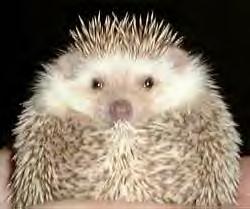Understanding Hedgehog Behavior


Communication
Since your hedgehog cannot talk, he will communicate his likes and dislikes to you through his body language and a few quiet vocalizations.
Here is a list of some things he’s trying to say:
Sounds
Soft Purring and Whistling:
This is a sign of pure contentment
Puffing:
Displeasure, uncertainty
Snorting or "Sneezing":
Usually accompanies puffing and means the same thing
Hissing and Clicking:
This means "get away from me, I’m scared or tired of you"
Snuffling:
Happily checking things out
Chirping:
Usually done by males while breeding and by nursing hoglets (babies)
Screaming:
Physical pain or fear
Sounds Heard During Sleep:
Believe it or not, some hedgehogs actually snore! Like dogs and cats, they also appear to dream and will sniff, snort and chirp quietly all the while.
Body Language
Rolled up ball:
* Fearful
Spines Erect:
* All Over: displeasure or fear
* On Forehead Only: Cautious, uncertain
* Spines Laying Flat All Over: Everything is fine. He feels comfortable and safe.
Self - Anointing:
If your hedgehog smells something he likes or if he simply comes across a smell that he is unfamiliar with, such as leather, perfume, etc., he will foam at the mouth and will then deposit this foamy saliva on his back and shoulders. In an effort to cover as much of their backs as possible with this foam, many hedgehogs will contort their bodies in such a way that they will sometimes fall over. Many hedgehogs become so engrossed with this activity that they become totally oblivious to anything going on around them! No one is really certain why hedgehogs perform this unusual behaviour (more often seen in males than females) but there is no shortage of theories.
One possible explanation is that they are trying to remember a particular smell by mixing it with the saliva and then depositing it on the spines. Another is that the foam acts as a repellant or toxin to a hedgehog's enemies. Whatever the reason, though, self-annointing is a normal occurrence and is no cause for alarm.
Circling:
To be perfectly honest, we don’t understand this behavior either, but it surely is good exercise! Circling should not, however, be mistaken for pacing - common in animals that are confined in too small an area - since hedgehogs in the wild frequently run circles as well. (Perhaps they know about the Olympics.) Not only do they run in circles, but they often run in figure-eights as well!
Awake Time
Your hedgehog is diurnal. This means that, like a cat, he will be awake during parts of both the day and night, but will be most active at dawn and after dark until 2 or 3 am. By handling him mostly during the daytime, you can easily change his sleep habits so that he will sleep more during the night and be more active during the day. If you are normally gone during the day, though, his normal sleep habits will most likely suit you just fine.
Thanks to the Hedgehog Hobby Page